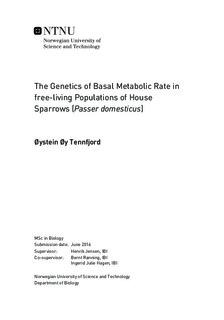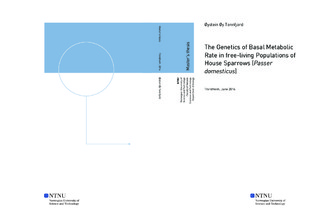| dc.description.abstract | Animals must allocate their energy reserves between growth, reproduction and survival. Basal metabolic rate (BMR) is a quantitative trait, which can represent the cost of living , and is a key component in the energy budget of animals. In this study, I explored the genetic basis of BMR through next-generation molecular methods, using individuals from wild populations of house sparrows (Passer domesticus). Birds from three genetically connected populations off the coast of mid-Norway were genotyped on a custom Affymetrix 200k SNP-chip, and were subsequently used in genome-wide association study (GWAS). BMR data from the study populations were collected during 2012-2015. One of three populations in this study was artificially founded in 2012 using a common garden approach. Founders from the two source populations had high and low BMR, respectively. Furthermore, the source populations were up-selected and down-selected for BMR 2012-2014. By using a recently developed GWA method that accounts for relatedness and repeated records from individuals, GWA analyses were performed within each island, and on a pooled dataset containing all individuals. Genetic variance components of BMR and the chromosomal contribution to variance in BMR were estimated via SNPs. In the three study populations of house sparrows, additive genetic variance for BMR was significant. Further, genomic partitioning of variance suggested an oligogenic architecture of BMR. It is plausible that the observed variation in BMR can be partly explained by rare loci of larger effect. The repeated GWAS showed mixed results. One suggestive SNP associated with BMR was detected in the pooled analysis, revealing a link between a genotype and BMR in wild house sparrows. However, within island analyses found no significant or suggestive signal for this SNP. Instead, another SNP was found to be associated with BMR within one of the islands. The implications of these findings are discussed in terms of the possible genetic architecture of BMR in these house sparrows, statistical power, biology and population structure. The present study is the very first to use SNPs to map QTLs for BMR in a wild population. Additionally, it contains the largest marker density in a wild outbred vertebrate population to date. The findings were mixed, but this study provides new knowledge about the link between genetics and phenotypic variation in BMR, which again give rise to new questions regarding the genetic architecture and eco-evolutionary dynamics of BMR. | |

